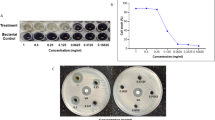Abstract
Candida tropicalis has emerged as the third most prevalent fungal pathogens and its ability to form biofilms has been considered one of the most important virulence factors, since biofilms represent high tolerance to antifungal agents. However, the mechanisms of C. tropicalis biofilm resistance to antifungals remain poorly understood. Thus, the main aim of this work was to infer about the effect of voriconazole on the formation and control of C. tropicalis biofilms and disclose its relationship with ERG genes’ expression. Planktonic cells tolerance of several C. tropicalis clinical isolates to voriconazole was determined through of antifungal susceptibility test, and the effect of this azole against C. tropicalis biofilm formation and pre-formed biofilms was evaluated by cultivable cells determination and total biomass quantification. ERG genes expression was analyzed by quantitative real-time polymerase chain reaction. This work showed that C. tropicalis resistance to voriconazole is strain dependent and that voriconazole was able to partially control biofilm formation, but was unable to eradicate C. tropicalis pre-formed biofilms. Moreover, C. tropicalis biofilms resistance to voriconazole seems to be associated with alterations of sterol content in the cell membrane, resulting in ERG genes overexpression. Voriconazole is unable to control C. tropicalis biofilms, and the overexpression of ERG genes is a possible mechanism of biofilm resistance.



Similar content being viewed by others
References
Silva S, Henriques M, Martins A, Oliveira R, Williams D, Azeredo J. Biofilms of non-Candida albicans Candida species: quantification, structure and matrix composition. Med Mycol. 2009;47:681–9.
Negri M, Silva S, Henriques M, Oliveira R. Insights into Candida tropicalis nosocomial infections and virulence factors. Eur J Clin Microbiol Infect Dis. 2012;31:1399–412.
Fridkin SK, Jarvis WR. Epidemiology of nosocomial fungal infections. Clin Microbiol Rev. 1996;9:499–511.
Silva S, Negri M, Henriques M, Oliveira R, Williams DW, Azeredo J. Candida glabrata, Candida parapsilosis and Candida tropicalis: biology, epidemiology, pathogenicity and antifungal resistance. FEMS Microbiol Rev. 2012;36:288–305.
Kojic EM, Darouiche RO. Candida infections of medical devices. Clin Microbiol Rev. 2004;17:255–67.
Eggimann P, Garbino J, Pittet D. Epidemiology of Candida species infections in critically ill non-immunosuppressed patients. Lancet Infect Dis. 2003;3:685–702.
Silva S, Henriques M, Oliveira R, Williams D, Azeredo J. In vitro biofilm activity of non-Candida albicans Candida species. Curr Microbiol. 2010;61:534–40.
Negri M, Martins M, Henriques M, Svidzinski TIE, Azeredo J, Oliveira R. Examination of potential virulence factors of Candida tropicalis clinical isolates from hospitalized patients. Mycopathologia. 2010;169:175–82.
Muñoz P, Giannella M, Fanciulli C, Guinea J, Valerio M, Rojas L, et al. Candida tropicalis fungaemia: incidence, risk factors and mortality in a general hospital. Clin Microbiol Infect. 2011;17:1538–45.
Douglas LJ. Candida biofilms and their role in infection. Trends Microbiol. 2003;11:30–6.
Bizerra FC, Nakamura CV, Poersch C, Svidzinski TIE, Quesada RMB, Goldenberg S, et al. Characteristics of biofilm formation by Candida tropicalis and antifungal resistance. FEMS Yeast Res. 2008;8:442–50.
Al-Fattani MA, Douglas LJ. Biofilm matrix of Candida albicans and Candida tropicalis: chemical composition and role in drug resistance. J Med Microbiol. 2006;55:999–1008.
Vandeputte P, Tronchin G, Bergès T, Hennequin C, Chabasse D, Bouchara J-P. Reduced susceptibility to polyenes associated with a missense mutation in the ERG6 gene in a clinical isolate of Candida glabrata with pseudohyphal growth. Antimicrob Agents Chemother. 2007;51:982–90.
Mishra NN, Prasad T, Sharma N, Payasi A, Prasad R, Gupta DK, et al. Pathogenicity and drug resistance in Candida albicans and other yeast species. Acta Microbiol Immunol Hung. 2007;54:201–35.
Baillie GS, Douglas LJ. Effect of growth rate on resistance of Candida albicans biofilms to antifungal agents. Antimicrob Agents Chemother. 1998;42:1900–5.
Kothavade RJ, Kura MM, Valand AG, Panthaki MH. Candida tropicalis: its prevalence, pathogenicity and increasing resistance to fluconazole. J Med Microbiol. 2010;59:873–80.
Williams DW, Wilson MJ, Lewis MAO, Potts AJC. Identification of Candida species by PCR and restriction fragment length polymorphism analysis of intergenic spacer regions of ribosomal DNA. J Clin Microbiol. 1995;33:2476–9.
CLSI. Reference method for broth dilution antifungal susceptibility testing of yeasts; fourth informational supplement. CLSI document M27-S4. Wayne: Clin. Lab. Stand. Inst. (CLSI); 2012.
Silva S, Hooper SJ, Henriques M, Oliveira R, Azeredo J, Williams DW. The role of secreted aspartyl proteinases in Candida tropicalis invasion and damage of oral mucosa. Clin Microbiol Infect. 2011;17:264–72.
Livak KJ, Schmittgen TD. Analysis of relative gene expression data using Real-Time quantitative PCR and the 2(-Delta Delta C(T)) method. Methods. 2001;25:402–8.
De Luca C, Guglielminetti M, Ferrario A, Calabr M, Casari E. Candidemia: species involved, virulence factors and antimycotic susceptibility. New Microbiol. 2012;35:459–68.
Fonseca E, Silva S, Rodrigues CF, Alves CT, Azeredo J, Henriques M. Effects of fluconazole on Candida glabrata biofilms and its relationship with ABC transporter gene expression. Biofouling. 2014;30:447–57.
Williams DW, Kuriyama T, Silva S, Malic S, Lewis MAO. Candida biofilms and oral candidosis: treatment and prevention. Periodontol. 2000;2011(55):250–65.
Silva S, Negri M, Henriques M, Oliveira R, Williams DW, Azeredo J. Adherence and biofilm formation of non-Candida albicans Candida species. Trends Microbiol. 2011;19:241–7.
Kumamoto CA. Candida biofilms. Curr Opin Microbiol. 2002;5:608–11.
Hawser SP, Douglas LJ. Resistance of Candida albicans biofilms to antifungal agents in vitro. Antimicrob Agents Chemother. 1995;39:2128–31.
Fernandes T, Silva S, Henriques M. Candida tropicalis biofilm’s matrix-involvement on its resistance to amphotericin B. Diagn Microbiol Infect Dis. 2015;83:165–9.
Mukherjee PK, Chandra J, Kuhn DM, Ghannoum MA. Mechanism of fluconazole resistance in Candida albicans biofilms: phase-specific role of efflux pumps and membrane sterols. Infect Immun. 2003;71:4333–40.
Acknowledgments
The authors thank the FCT for the Strategic Project of the UID/BIO/04469/2013 unit, FCT and European Union funds (FEDER/COMPETE) for the project RECI/BBB-EBI/0179/2012 (FCOMP-01-0124-FEDER-027462). We also would like to acknowledge Pfizer®, S.A. for the kindly donation of voriconazole.
Author information
Authors and Affiliations
Corresponding author
Rights and permissions
About this article
Cite this article
Fernandes, T., Silva, S. & Henriques, M. Effect of Voriconazole on Candida tropicalis Biofilms: Relation with ERG Genes Expression. Mycopathologia 181, 643–651 (2016). https://doi.org/10.1007/s11046-016-0023-6
Received:
Accepted:
Published:
Issue Date:
DOI: https://doi.org/10.1007/s11046-016-0023-6




